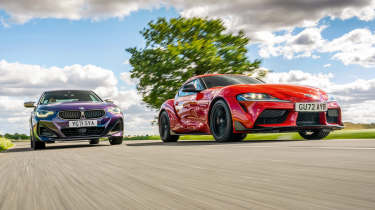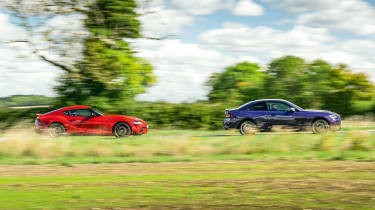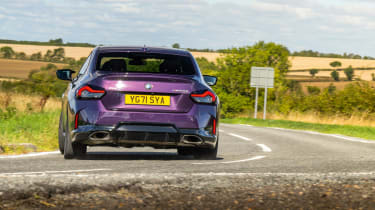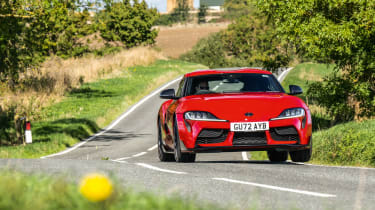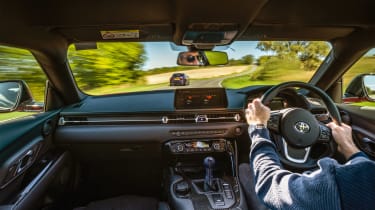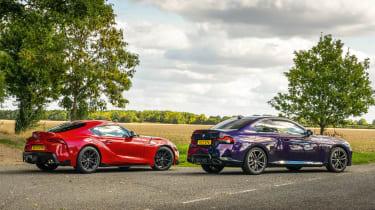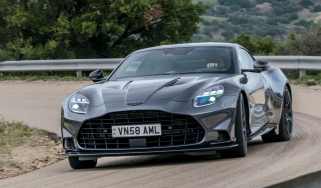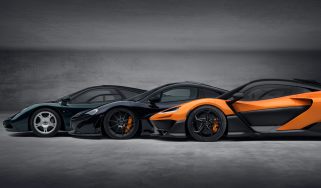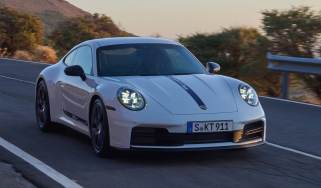Toyota GR Supra v BMW M240i xDrive – six-cylinder coupes go head-to-head
Now with a manual gearbox, Toyota’s GR Supra takes on BMW’s M240i xDrive: two compact coupes with much in common, but which delivers the biggest thrills?
This should be a easy slam dunk. The M240i xDrive might have a slightly more powerful version of the lovely ‘B58’ 3-litre turbocharged in-line six-cylinder engine that it shares with the revised Supra, but in every other department the Toyota holds all the aces. Firstly, it’s now available with a six-speed manual gearbox. This is the sort of U-turn we support wholeheartedly. It’s also smaller, lower, has a stiffer structure and weighs 188kg less than the astonishingly heavy BMW. The Supra offers the purity of rear-wheel drive and the playfulness of an e-diff and it is exotic and intriguing where BMW’s latest coupe seems at once conventional yet wilfully awkward. The two-seater Toyota has a higher starting price – £53,495 to the M240i’s £47,515 – but that seems fitting for a tough-looking, focused sports car with an iconic badge that promises greater engagement and sharper dynamics.
If only life were so simple. The Supra has, up to now, been one of those tantalising ‘nearly’ cars. I revisited the press pack before taking delivery of this car and it really pulls at the heart strings. Stiffer structurally than an LFA; ‘conceived as a sports car in its purest form’; tested exhaustively at the Ring; developed by Toyota Gazoo Racing with learnings from motorsport success; strict adherence to the golden ratio between track width and wheelbase (this was new to me but 1.55 is the magic number, apparently); a shorter wheelbase and lower centre of gravity than even the GT86 for ultimate agility. It’s a great piece of persuasive writing littered with quotes from chief engineer Tetsuya Tada, emotive language and packed with engineering detail. The Supra doesn’t half sound good on paper.
> 2022 BMW M2 revealed – the baby M is all grown up
So why has it always slightly underwhelmed? That breathless press pack makes no mention of the shared platform with the Z4. Understandable, as BMW’s sports car has always shied away from being an actual sports car. Sometimes it feels like it wants to be anything but. The Supra really wants to be a sports car but up to now it’s always been unable to fully escape the deliberately dulled dynamics of the Z4. Strong in terms of performance and outright grip but lacking in detail, clarity and bright, exciting dynamics. We like it, but where’s the magic?
The addition of a manual gearbox alone is unlikely to change things. However, it’s a shining beacon of hope and a clear signal of intent. The Supra is getting serious. Not only does it offer something unique – BMW doesn’t offer that fabulous engine with a six-speed ’box – but Toyota has also taken the opportunity to revise the suspension and steering and add new features to the driver aids to increase involvement, agility and playfulness too. Early reports suggest this new Supra is much improved. So, before we throw it to the wolves (also known as a twin-test with a Cayman S) we thought a glorious beating of the new gawky fat kid from BMW was in order. This is the Supra’s moment to shine.
The thing is, nobody seems to have told the M240i xDrive that it’s the fall guy. This is a complex, at times infuriating car and it requires patience, lots of playing with various settings and modes and an open mind to fully understand. However, once you start to gel with the way it operates, the M240i is astoundingly capable, impressively poised and genuinely exciting. Fast, too. Despite weighing 1690kg (yes, I have checked this more than once. Blame the fact it shares the 3/4-series platform) this four-seater coupé is a rocketship. BMW claims 0-62mph in 4.3 seconds, a perfect match for the automatic Supra but 3/10ths quicker than the three-pedal car. It feels even quicker than that.
The BMW’s version of the 3-litre, single-turbocharged straight-six produces 369bhp at 5500rpm and 369lb ft from 1900rpm. In combination with an eight-speed automatic ’box with tightly stacked ratios, the thing feels always on, always ready. There’s lovely mid-range response but even better is the high-rev energy. There’s so much bite and sharpness. The Supra has a shorter final drive but just six ratios to play with and the engine is down slightly with 335bhp at 5000rpm, although its identical 369lb ft comes in slightly lower at 1600rpm.
Things don’t get off to a great start in the M240i xDrive. It doesn’t feel vast in the way of a new M4, but it is tall and, although you sit low within the car itself, the hip point doesn’t feel very sports car in actuality. The interior is of superb quality and feels expensive and beautifully thought out. Again though, it doesn’t scream that you’re in something focused and special. The engine, however, does feel good immediately. Great, in fact. So smooth that it doesn’t reverberate around the car even on a cold start. Instead it pours into the cabin and then settles like a vast lake on a still day. Immense but calm as can be.
Yet on the move the engine’s class and quality is undermined. The steering feels light and there’s so little self-centring that just making fluid progress requires thought and effort. The ride is heavy – supple enough to smother little bumps but then heaving over big undulations. There’s inertia evident everywhere, even if the engine seems to pick up that weight with little effort and the eight-speed ’box snaps through changes with a lovely sense of precision.
There are modes. Many modes. ‘Comfort’ presents with this skewed mismatch between an engine eager to please and a chassis reluctant to offer feedback. ‘Sport’ improves things, bringing a greater sense of connection, slightly more steering weight and a more natural feel to the way the car flows through a sequence of corners. But you pay a price in ride quality. The M240i becomes unyielding at times and it feels like the car is full of a tension. Not the good sort of alert, reactive tension. More like its muscles are seized tight. All the subtlety and nuance is gone, unable to fight past the clenched sinews.
Counter-intuitively, the BMW gets better in the even stiffer, more aggressive Sport Plus mode. Partly this is due to the excellent body control it brings. The M240i feels extremely stiff at low speeds in Sport Plus but then finds a happy groove as you break free from traffic and small towns or villages. The ride remains sharp-edged but it’s decisive at dealing with whatever is thrown at it and there’s plenty of suspension travel, too. The result is that the car’s tendency to skip a little over broken surfaces or hunt around as the topography ebbs and flows is much reduced and you can start to enjoy the smooth savagery of the engine and flick up and down the close ratios to explore the depth of the performance on offer.
Better still, it seems to really unleash the potential of the four-wheel-drive system. The M240i is rear-drive by nature with an electronically controlled rear differential just like, say, an M2 or M4. Power is progressively sent forwards as the system detects slip. However, there’s also torque-vectoring capability, although it’s done through braking an inside wheel rather than the differential actively throwing all the power to the outside rear wheel as in, say, an Audi RS3. The press material for M240i is very non-specific about exactly what happens in Sport Plus mode, but I sense it’s utilising the torque-vectoring much more aggressively and, in combination with a more neutral balance brought about by the much stiffer rear end, the whole car suddenly comes to life.
The front-end is nailed on, the car wants to rotate and the rear is active from the turn-in phase right to the exit, adopting yaw from the apex and holding a delicious little angle as the engine rips up to its ferocious top-end. It’s like the inherent traction afforded by the four-wheel-drive system has freed up BMW to be daring with the balance of the car. This combination of adjustability and stunning traction is really quite something to behold for a sub-M car. And because it is a little narrower and more compact than an M4, the M240i gives you a greater sense of freedom to indulge in what it can do. It’s a chunky thing when you look at the spec sheet, but in terms of physical size it’s not a bad compromise for our roads.
For a car that seems to plunge a dagger into the heart of our notions of purity in terms of mass, an automatic gearbox, adopting four-wheel drive and insisting upon a dizzying number of modes (you can configure a Sport Individual with your own preferences for suspension, steering, engine response, etc, too), the M240i xDrive really can deliver an intense, intuitive and exciting driving experience. It’s just a shame you have to go looking for it.
The Supra is unquestionably a more special object. I’ve really grown to love the looks over time and, despite being familiar, it still seems audacious. The double-bubble roof is killer, the complex, crazy rear end is creative and feels daringly Japanese and the proportions really do call to mind the gorgeous old 2000 GT. Much may be shared with the Z4, but there’s no question that the Supra has its own visual identity and one that pays homage to Toyota’s heritage. In short, it makes the BMW appear bloated, ungainly and very humdrum.
Oh man, I hate those blanked-off ‘vents’ and ‘intakes’, though. They are a little thing but they really sting. For something purporting to be an authentic sports car, the sheer fakery is unforgivable. Every time you open the door to the Supra and your eyes fall upon the blanking trims ahead of the rear wheelarch the hard won magnetism it possesses bleeds away a little bit more.
Drop way down into the driver’s seat and the Supra’s credentials are rediscovered. Yes, it’s all very BMW in here, but the things that count are dead right. You sit low, almost over the rear axle, legs virtually straight, and the steering wheel can be pulled out towards your chest. It’s a smaller wheel than the BMW’s and has a thinner rim. Oh, and where once was a generic BMW automatic shifter is now a short lever with a delicate-looking sphere attached to it. Etched into its face is a H-pattern for the six-speed ’box. The pedals feel a little offset to the right, but looking out over the long bonnet, practising a few up- and down-shifts and tweaking the steering wheel and seat position, life feels pretty good. The Supra feels so much smaller, so much more exciting.
Toyota will have gone to great lengths to make the engine sound different. Less distinctly BMW. Yet you can’t hide this straight-six’s basic rightness, and nor should you. So the character is similar and, if anything, the Supra is quieter and more silken. The manual lever doesn’t so much as tremble. But selecting 1st, feeling the light, direct shifting action and appreciating the positioning high up on the centre console is oddly satisfying. A manual ’box is so rare these days that it really is an event. A sort of ritualistic celebration of driving even before you start driving.
First impressions are the exact opposite of the BMW. The ride isn’t busy or inconsistent, rather it’s smooth and considered. The steering is heavier but also slower in its rate of response. In fact, the Supra feels altogether calmer. The longer gear ratios take away some of the zip that’s ever-present in the M240i, too. There’s certainly more maturity and the very act of changing gear brings immediate involvement, but I can’t help feeling it’s all a bit too measured. Perhaps even tipping over into detachment. The Supra does everything you ask of it and is pleasingly taut and accurate but there’s very little in the way of feel. The body language of the car is more conventional than the stance, proportions and sports car aspirations would suggest, too.
Having said that, the Supra does feel much smaller than the BMW. It’s considerably shorter and lower and, although it doesn’t actually change direction any faster, the Toyota seems to require less effort to do so. There’s less mass to control and you can feel the benefits of the low centre of gravity. Despite that slightly slower steering ratio you’d swear the front is more responsive and oddly, despite being the wider of the two cars, the Supra seems to thread down narrow roads more easily. It’s amazing the illusion that a short wheelbase, lower mass and a ground-hugging seating position can conjure. It seems to create space and options.
Like the M240i, the Supra has an e-diff at the rear and this revised car has a couple of new electronic features, too. The Hairpin+ feature allows more wheelspin on tight uphill corners (not much use in Bedfordshire) and the new Anti-Roll programme actually makes the stability control system step in earlier in the stiffer Sport mode to counter the danger of sudden oversteer. This is interesting as it does rather back up the conclusion that the BMW can aggressively chase a neutral balance and rely on its four-wheel-drive system to help, whereas the Supra instead is trying to tame the car with electronics. Of course, you can always turn them off.
In search of a bit more grit and intensity, it’s inevitable that you’ll select Sport mode and loosen the stability control. Perhaps, I ponder, this will bring the car to life much as Sport Plus does with the M240i. To a certain extent, it’s a good bet. The ride becomes much more aggressive, the balance swings just enough to make the Supra feel more positive on turn-in and you start to notice other strong points, too. Most starkly, the excellent brake feel that easily beats the BMW’s approach, which is initially sharper but much less progressive and less easily to modulate. Rowing that lovely ’box along and using the massive mid-range torque, the Supra starts to reveal a new side to its character.
And yet there’s always something pulling it back just enough to interrupt the enjoyment. The engine isn’t as fiery at the top end as the BMW’s. The rear axle becomes very unsettled over bumpy roads. Even the balance itself feels safer and more conservative. The car is just less alive to throttle and braking inputs. If you do breach the limit, the Supra is very easy to bring neatly back into line, but it doesn’t feel hugely enthusiastic about being overdriven. There are glimpses of brilliance but there’s just not enough detail, enough texture zinging through the seat and steering. And where the BMW gets better the harder you go, the Supra starts to run out of composure. The brakes remain fantastic and there’s no lack of grip, but the suspension struggles to keep the wheels in contact with the surface. The Supra’s natural comfort zone is some way behind that lovely engine’s capability or the ultimate grip of the Michelin tyres.
This isn’t an unforgivable sin. A sports car should entertain at any speed and just because it can’t quite cut it at maximum attack shouldn’t be a killer blow. However, the Supra’s lack of steering feel in particular makes you go looking for something else to engage with, so you drive harder. The fact that the disconnect only grows as the speeds pick up is a disappointment. I want to love the Supra but can’t quite reconcile the on-paper promise with the aloof, cautious reality, nor the way it runs out of ideas just when the BMW finally comes together as a driving experience.
Neither of these cars is perfect. The BMW can feel brittle at times and requires a lot of commitment to find its talents. But they’re in there. Elusive but not impossible to find. The Supra feels smaller, lighter and more exploitable at first, but it rarely draws you into the driving experience and simply doesn’t have the feedback to fully immerse the driver. The manual gearbox improves the experience. It’s a touchpoint that requires skill and encourages you to harmonise with that wonderful engine. It’s a sweet, precise tool and feels a fitting gearbox for a true sports car. Let’s hope Toyota continues to chip away until it makes the Supra exactly that.
Specs
| Toyota GR Supra | BMW M240i xDrive Coupe | |
| Engine | In-line 6-cyl, 2998cc, turbo | In-line 6-cyl, 2998cc, turbo |
| Power | 335bhp @ 5000rpm | 369bhp @ 5500rpm |
| Torque | 369lb ft @ 1600-4500rpm | 369lb ft @ 1900-5000rpm |
| Weight | 1502kg | 1690kg |
| Power-to-weight | 227bhp/ton | 222bhp/ton |
| 0-62mph | 4.6sec | 4.3sec |
| Top speed | 155mph | 155mph |
| Basic price | £53,495 | £47,515 |
This story was first featured in evo issue 303.

